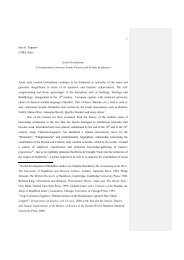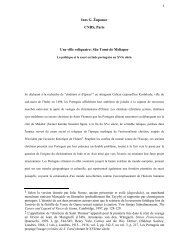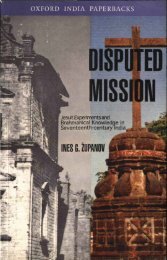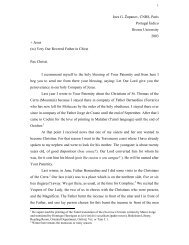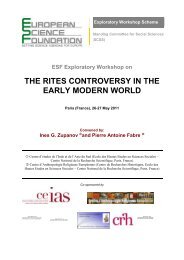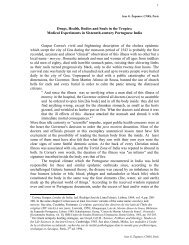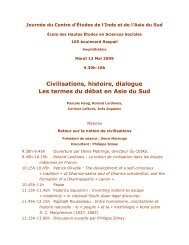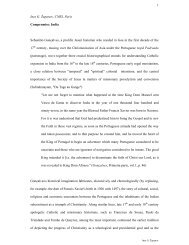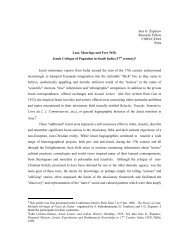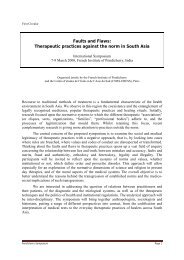Professional Missionary and Orientalist Curator ... - Ines G. Županov
Professional Missionary and Orientalist Curator ... - Ines G. Županov
Professional Missionary and Orientalist Curator ... - Ines G. Županov
Create successful ePaper yourself
Turn your PDF publications into a flip-book with our unique Google optimized e-Paper software.
207 <strong>Professional</strong> <strong>Missionary</strong> <strong>and</strong> <strong>Orientalist</strong> <strong>Curator</strong><br />
ary fieldwork as his ongoing interest in European theories <strong>and</strong> books<br />
on just about everything. Paulinus’s Viaggio belongs to a particular<br />
sub-genre of travel literature developed by the Italians <strong>and</strong> other<br />
Europeans in the course of almost three centuries of their Oriental<br />
expeditions. The narrative of this kind of travelogues is structured<br />
as a museum, with exotic «objects» classified <strong>and</strong> stored in different<br />
«disciplinary» compartments supplemented with author’s omnipresent<br />
<strong>and</strong> atemporal voice of assessment 12 .<br />
It was upon return from India 1789, Paulinus wrote, as he travelled<br />
through France «devastated» by the Revolution that he started<br />
«thinking about countries <strong>and</strong> nations that [he] saw <strong>and</strong> comparing<br />
them with Europeans, my dear compatriots» 13 . Endowed with comparative<br />
perspective, after a long fieldwork in Asia, he recognized<br />
clearly Europe’s weaknesses <strong>and</strong> achievements. Therefore, he concluded,<br />
since China <strong>and</strong> India were regions with gentile <strong>and</strong> gentle<br />
people governed by simple laws <strong>and</strong> stable governments, their religion<br />
<strong>and</strong> customs remained unchanged. Europe was, by contrast, «inconstant»<br />
<strong>and</strong> politically volatile, for which he had a historical <strong>and</strong><br />
racial explanation. What explained it was the influx of the ferocious<br />
Scythians from the cold climates at one point in Europe’s history.<br />
One of the consequences of this inbuilt mobility of the Europeans<br />
who also became conquerors of the rest of the world <strong>and</strong> thus developed<br />
excellent armies is that they acquired «one little advantage»<br />
compared to Asia. «This advantage lies in arts <strong>and</strong> sciences», in spite<br />
of the fact that, Paulinus argued, it was India where arts <strong>and</strong> sciences<br />
12<br />
See the publications of his predecessors: Giuseppe di Santa Maria Sebastiani,<br />
Prima speditione all’Indie orientali... Ordinata da Nostro Signore Aless<strong>and</strong>ro Settimo,<br />
Roma, Filippo Maria Mancini 1666; Id., Seconda speditione all’Indie orientali... Ordinata<br />
da Aless<strong>and</strong>ro Settimo di gloriosa memoria, Roma, Filippo Maria Mancini 1672;<br />
Vicenzo Maria di Santa Caterina da Siena (alias Vincenzo Maria Murchio), Il<br />
viaggio all’Indie Orientali del padre F. Vincenzo Maria di S. Caterina da Siena Procurator<br />
Gener. de’ Carm. Scalzi, con le osseruationi, e successi nel medesimo, i costumi, e riti di<br />
varie nationi, et reconditissimi arcani de’ gentili, cauati con somma diligenza da’ loro scritti,<br />
con la descrittione degli Animali Quadrupedi, Serpenti, Uccelli, Piante di quel Mondo<br />
Nuovo, con le loro virtu singolary, Diuiso in cinque libri. Opera non meno Utile, che<br />
curiosa, Venetia, Giacomo Zattoni 1678. For the general discussion see D.F. Lach,<br />
E.J. Van Kley, Asia in the Making of Europe, 3 vols., Chicago-London, University of<br />
Chicago Press 1994-1998, III (1998), A century of Advance, pp. 383-385.<br />
13<br />
Paulinus, Viaggio cit., pp. 391-392.




